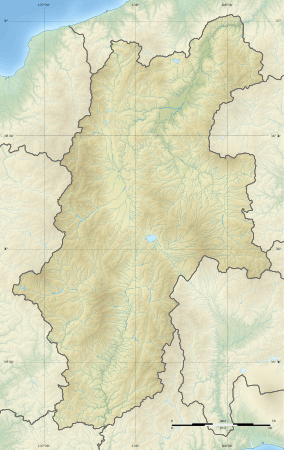Akyū ruins
Akyū ruins (阿久遺跡, Akyū iseki) is an archaeological site containing the ruins of a large-scale Jōmon period settlement located in what is now part of the village of Hara, Nagano in the Chūbu region of Japan. It contains the largest stone circle yet found in Japan. The site was designated a National Historic Site of Japan in 1979.[1]
阿久遺跡 | |
Akyū ruins | |
 Akyū ruins  Akyū ruins (Japan) | |
| Location | Hara, Nagano, Japan |
|---|---|
| Region | Chūbu region |
| Coordinates | 35°57′53″N 138°11′18″E |
| Type | settlement |
| History | |
| Periods | Jōmon period |
| Site notes | |
| Ownership | National Historic Site |
| Public access | None |
Overview
The site is located at the southeastern foot of Mount Yatsugatake at an altitude of 904 meters, and covers 56,000 square meters on a ridge north of the Hara Interchange on the Chūō Expressway. Until the discovery of the Sannai-Maruyama site in Aomori Prefecture, it was the largest Jōmon site in Japan. The site was discovered during construction work on the Chūō Expressway and an excavation survey was performed in 1975. As the route of the expressway would have destroyed the site, the area was backfilled after the survey was completed, and the expressway was built on top of the backfill layer, with the aim of preserving the ruins underneath.
The site appears to have been continuously occupied for several thousand years from the early to the end of the Jōmon period. The foundations of 30 round pit dwellings and eight square pillared dwellings from the early Jōmon period (4000–2500 BCE) and 20 pit dwellings and several graves from the middle Jōmon period (2500–1500 BCE) were excavated. The stone circle dates from the late Jōmon period (1500–300 BCE), and was constructed in the middle of the settlement.
The stone circle was donut-shaped, with a major diameter of 120 meters and a minor diameter of 90 meters, and contained an estimated 200,000 fist-sized river rocks. In the center was a stone structure made of 24 large and small andesite stones, and eight smaller stone circles with a radius of around one meter. The center complex was surrounded by an estimated 700 tombs.
Some of the artifacts recovered from the site are on display at the Yatsugatake Museum of Art, also located in the village of Hara.
References
- "阿久遺跡" (in Japanese). Agency for Cultural Affairs.
External links
- Hara village official site (in Japanese)